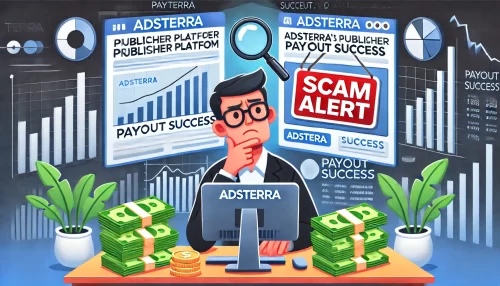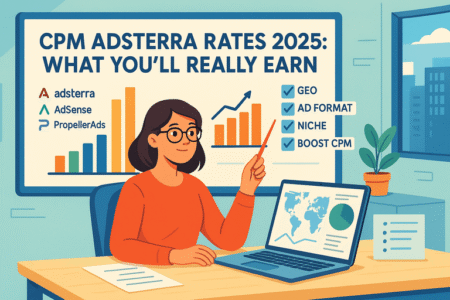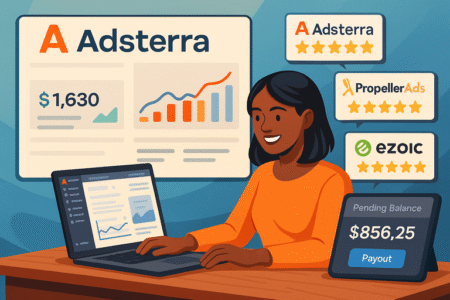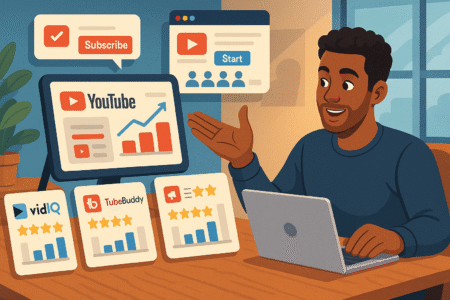Table of Contents
Promote your website before it gets lost in the endless sea of online competition. Are you struggling to get visitors? Wondering why your content isn’t reaching the right audience? Or maybe you think simply launching your site is enough? It’s not.
Without active promotion, even the best websites fail to gain traction. But don’t worry—you’re not too late! In this guide, we’ll cover the essential steps to boost visibility, drive traffic, and ensure your site gets the attention it deserves. Ready to take action? Let’s dive in!
Understand Why Website Promotion is Critical
Many website owners believe that simply launching a site is enough to attract visitors. But without strategic promotion, even the best websites struggle to gain traction. Let’s explore why promoting your website is essential for success.
The Consequences of Ignoring Promotion
Failing to promote your website can lead to frustrating results. No matter how great your content or design is, without visibility, your efforts will go unnoticed.
For many, the biggest consequence is low traffic. A website without visitors is like a store with no foot traffic—there’s no one to buy, engage, or even share your content. Search engines prioritize active websites, meaning sites with little engagement will rank lower over time, making it even harder to gain traction.
Another major issue is lost revenue opportunities. Whether you sell products, services, or rely on ad revenue, a lack of visitors means fewer chances to generate income. Businesses that neglect promotion often find themselves spending more money on their websites than they earn from them.
Brand credibility also suffers. People tend to trust businesses with a strong online presence. If your competitors are ranking higher, appearing on social media, and engaging with customers, but your website is nowhere to be found, potential clients may assume your brand isn’t as credible or established.
Ignoring website promotion can also create a compounding effect. The longer you wait to start, the harder it becomes to catch up. Websites that start early and consistently engage in promotion build authority, while those that delay struggle to compete later on.
How Early Promotion Impacts Long-Term Growth
The sooner you start promoting your website, the better. Many successful websites gained their momentum by investing in visibility from day one. Early promotion allows search engines to index your site faster, leading to quicker rankings and more organic traffic.
Establishing authority early on is another advantage. The longer your website is active and consistently producing valuable content, the more trust it earns from both users and search engines. Websites that have been around for years naturally rank higher than new ones due to their history of engagement and backlinks.
Promotion also helps build a loyal audience. If you start engaging with visitors early—through social media, email marketing, or SEO—they’ll remember your brand and return for more content. This creates a strong foundation of recurring visitors, leading to long-term growth.
Let’s not forget the financial benefits. Early promotion ensures your website starts generating revenue sooner rather than later. Whether through ads, sales, or affiliate marketing, attracting traffic early puts your monetization strategy into action faster.
Common Myths About Website Marketing
There are plenty of misconceptions about website promotion that hold people back from taking action. Let’s break them down.
One of the biggest myths is that “If I build it, they will come.” Unfortunately, this isn’t true. Search engines and social media algorithms don’t automatically send visitors to new sites. You have to put in the work to drive traffic.
Another common belief is that SEO alone is enough. While SEO is a powerful strategy, it’s just one piece of the puzzle. Relying solely on organic traffic without social media, email marketing, or paid ads can limit your reach.
Some people also assume that website promotion is too expensive. While paid advertising can be costly, many promotional strategies—such as SEO, content marketing, and social media engagement—are free or low-cost. Even a small budget can yield great results if spent wisely.
Lastly, there’s the idea that only big brands can compete online. In reality, smaller websites can outperform larger competitors with the right strategies. Focusing on niche audiences, long-tail keywords, and personalized engagement can give smaller sites a competitive edge.
Optimize Your Website for Search Engines

If you want your website to attract organic traffic, search engine optimization (SEO) is essential. A well-optimized site ranks higher on Google, increasing visibility and bringing in more visitors. Here’s how to optimize your site for success.
Conduct Keyword Research for Maximum Visibility
Keyword research is the foundation of SEO. It helps you understand what your audience is searching for and allows you to create content that aligns with their needs.
Start by using tools like Google Keyword Planner, or SEMrush to identify relevant search terms in your industry. Look for keywords with a balance of high search volume and low competition—these are easier to rank for.
It’s also important to focus on long-tail keywords—phrases that are more specific and often less competitive. For example, instead of targeting “digital marketing,” a long-tail keyword like “best digital marketing strategies for small businesses” will attract a more targeted audience.
Once you’ve identified your keywords, incorporate them naturally into your content. This includes your headings, meta descriptions, URLs, and image alt text. However, avoid keyword stuffing—Google prioritizes high-quality content over excessive keyword usage.
Improve On-Page SEO for Higher Rankings
On-page SEO refers to the elements you control within your website to improve rankings. This includes optimizing your content, structure, and technical elements.
One of the most important factors is creating high-quality content. Google rewards websites that provide valuable, in-depth information. Focus on answering your audience’s questions clearly and thoroughly.
Title tags and meta descriptions also play a huge role. Your title tag should include your main keyword and be compelling enough to attract clicks. The meta description should summarize your page’s content and encourage users to visit your site.
Another crucial aspect is header tags (H1, H2, H3, etc.). Properly structured headings improve readability and help search engines understand your content better.
Don’t forget about image optimization. Large image files slow down your website, affecting user experience and SEO. Use compressed images and add alt text with relevant keywords to improve accessibility and search rankings.
Enhance Site Speed and Mobile Usability
A slow website hurts your rankings and frustrates visitors. Research shows that 53% of users leave a site if it takes longer than 3 seconds to load. Improving your site speed is a must.
To boost loading times:
- Use a content delivery network (CDN) to distribute your content across multiple servers.
- Optimize images by compressing them without losing quality.
- Minimize unnecessary plugins that slow down your site.
- Enable browser caching so returning visitors experience faster load times.
With over 60% of online traffic coming from mobile devices, mobile optimization is no longer optional. Use Google’s Mobile-Friendly Test to check your site’s responsiveness. Ensure your website has a clean, easy-to-navigate design that works seamlessly on all screen sizes.
Build a Strong Internal Linking Strategy
Internal linking connects different pages on your website, improving navigation and boosting SEO. It helps search engines understand your site structure and encourages visitors to explore more content.
A solid internal linking strategy involves:
- Linking to relevant blog posts and pages within your content.
- Using descriptive anchor text that tells users and search engines what the linked page is about.
- Keeping a balanced link structure—avoid excessive links on one page while neglecting others.
Internal links also help distribute link equity (ranking power) across your site. When a high-ranking page links to another page, it passes authority, helping other pages perform better in search results.
Leverage Content Marketing to Attract Visitors
Content marketing is one of the most powerful ways to promote your website and build lasting connections with your audience. By consistently creating valuable content, you can improve search engine rankings, attract targeted visitors, and establish your brand as an authority.
Create High-Quality Blog Posts That Rank
A well-optimized blog is a traffic magnet. Blog posts allow you to target relevant keywords, provide in-depth information, and give search engines more content to index.
To create high-ranking blog posts, start with strong keyword research. Tools like Google Keyword Planner, Ahrefs, and SEMrush help identify what your audience is searching for. Target long-tail keywords with lower competition to improve your chances of ranking.
Content quality is just as important as keywords. Google prioritizes in-depth, valuable, and well-structured content. Each post should answer a specific question or solve a problem your audience faces. Aim for at least 1,500 words per post, but focus on depth over word count.
Formatting matters. Use clear headings (H2, H3), bullet points, and short paragraphs to enhance readability. Including internal links to other relevant blog posts improves SEO and keeps readers engaged.
Promotion is key. Share your posts on social media, email newsletters, and online communities to maximize visibility. The more engagement your content gets, the better it performs in search rankings.
Utilize Video Marketing for Better Engagement
Videos are an essential part of content marketing. With platforms like YouTube, TikTok, and Instagram Reels, video content can help you reach wider audiences and increase engagement.
Start with educational or how-to videos that answer common questions in your industry. Short explainer videos, tutorials, and behind-the-scenes footage work well. If you’re in e-commerce, product demonstration videos can boost conversions.
Video SEO is just as important as written content. Use keyword-rich titles, descriptions, and tags to optimize your videos for search engines. Transcribe your videos to make them accessible and improve rankings.
Repurpose blog content into videos. If you have a high-performing blog post, turn it into a short video summary or an in-depth explainer video to drive more traffic.
Consistency matters. Post videos regularly and engage with your audience through comments and Q&A sessions to build a loyal following.
Develop Shareable Infographics and Visuals
People retain 65% of visual content compared to only 10% of written text. Infographics make complex information easier to understand and are highly shareable across social media and blogs.
Use tools like Canva, Piktochart, or Adobe Illustrator to create eye-catching infographics. Focus on data-driven insights, step-by-step guides, or industry trends that provide immediate value.
To maximize reach, embed infographics in blog posts, share them on Pinterest, and submit them to infographic directories. Encourage website visitors to share your visuals by offering an embed code below the infographic.
Well-designed graphics also boost engagement on LinkedIn, Twitter, and Instagram, driving more traffic back to your website.
Repurpose Content Across Multiple Platforms
Repurposing content allows you to reach different audiences without constantly creating new material. A single blog post can be transformed into multiple content formats, extending its lifespan.
Here’s how:
- Convert blog posts into email newsletters to engage subscribers.
- Turn key takeaways into social media posts with eye-catching graphics.
- Transform detailed guides into downloadable PDFs or lead magnets.
- Use blog topics as discussion points for podcasts or webinars.
Repurposing saves time while maximizing the impact of your content marketing strategy.
Build a Strong Social Media Presence
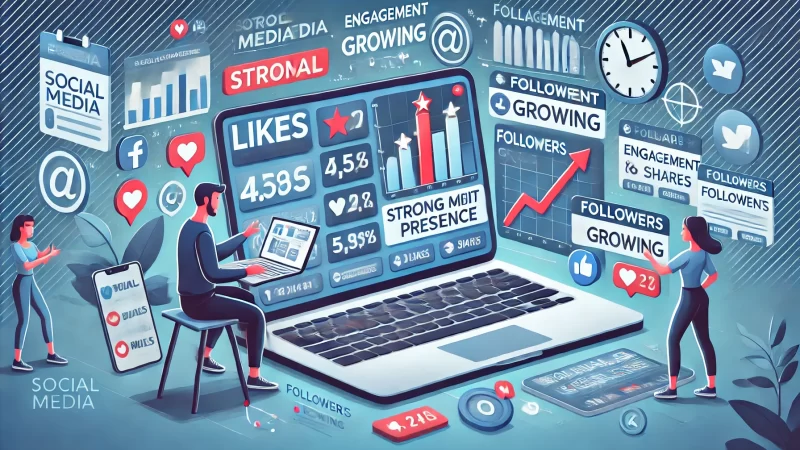
A strong social media presence helps drive traffic, boost brand awareness, and engage potential customers. Choosing the right platforms and posting consistently ensures your content reaches the right audience.
Choose the Right Platforms for Your Niche
Not every social media platform is right for every business. Identifying where your audience spends time is crucial.
- Instagram & TikTok – Ideal for brands relying on visual storytelling, fashion, beauty, and lifestyle businesses.
- Facebook – Best for community building, paid ads, and engaging diverse demographics.
- LinkedIn – Perfect for B2B businesses, thought leadership, and professional networking.
- Twitter/X – Great for industry updates, engagement, and real-time conversations.
- Pinterest – Works well for businesses in fashion, home decor, and DIY niches.
Instead of spreading too thin, focus on 2–3 platforms where your audience is most active and create content tailored to each platform’s format.
Post Consistently and Engage With Followers
Consistency is key. Brands that post frequently see higher engagement and visibility. Plan your posts using a content calendar to stay organized.
Beyond posting, engagement is crucial. Responding to comments, joining discussions, and engaging with your audience’s posts builds relationships and increases visibility.
Live streaming and Q&A sessions also work well. Hosting live videos on Instagram, TikTok, or Facebook fosters real-time interaction and trust.
Use Paid Social Ads to Boost Reach
Organic reach is limited. Running paid social media ads helps expand your audience and target potential customers based on demographics, interests, and behavior.
Platforms like Facebook Ads and Instagram Ads offer precise targeting. You can:
- Promote blog content or product pages to a larger audience.
- Retarget users who visited your site but didn’t convert.
- Use lookalike audiences to reach new potential customers.
A small ad budget of $5–$10 per day can generate thousands of impressions and drive consistent traffic.
Collaborate With Influencers for Greater Exposure
Partnering with influencers in your niche boosts credibility and expands your reach. Micro-influencers (10k–50k followers) often deliver better engagement than larger influencers.
Influencer collaborations can include:
- Sponsored posts featuring your website or product.
- Giveaways where influencers promote your brand.
- Guest blogging or podcast appearances.
Choosing authentic influencers who align with your brand leads to higher engagement and trust.
Implement an Effective Email Marketing Strategy
Email marketing remains one of the highest-ROI digital marketing strategies. A strong email list allows you to engage with your audience directly and drive repeat traffic.
Build and Grow Your Email List Organically
A high-quality email list is built over time. Instead of buying lists, focus on organic growth through:
- Lead magnets – Offer free e-books, checklists, or exclusive content in exchange for email signups.
- Pop-ups & forms – Use well-placed website pop-ups with compelling CTAs.
- Webinars & online events – Require email registration for participation.
Delivering valuable content builds trust and increases email open rates over time.
Craft Engaging Email Campaigns That Convert
Every email should provide value. Avoid overly promotional emails and focus on:
- Educational content (blog post summaries, industry tips).
- Personalized product recommendations.
- Exclusive discounts or early access offers.
Use compelling subject lines to increase open rates and make emails visually engaging with clear CTA buttons.
Use Automation to Nurture Leads Efficiently
Automated email sequences save time and keep your audience engaged without manual effort.
- Welcome emails introduce new subscribers to your brand.
- Drip campaigns gradually educate leads about your products or services.
- Cart abandonment emails remind customers to complete purchases.
Email automation tools like Mailchimp, ActiveCampaign, and ConvertKit simplify the process.
Segment Your Audience for Better Results
Not all subscribers are the same. Segmenting your list improves engagement by delivering personalized content based on:
- Past purchases or website activity.
- Demographic data (age, location, preferences).
- Engagement levels (active vs. inactive subscribers).
A well-segmented email list leads to higher conversions and lower unsubscribe rates.
Utilize Paid Advertising for Instant Traffic
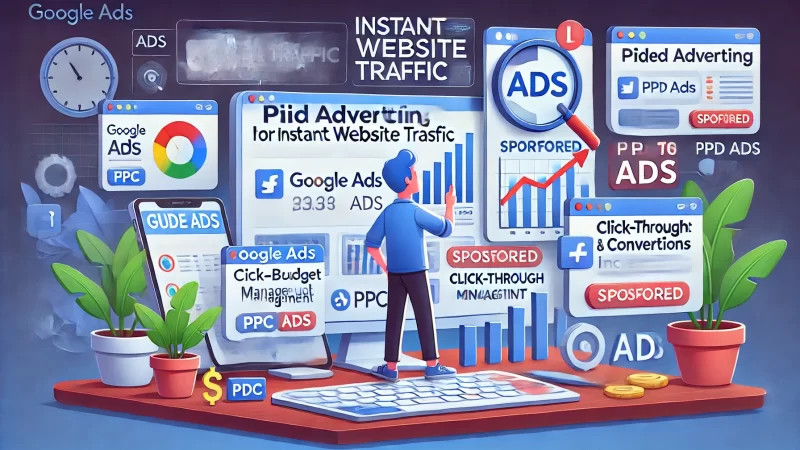
Organic strategies take time, but if you want immediate traffic, paid advertising is the way to go. With targeted ads, you can reach the right audience quickly and drive visitors who are ready to engage with your content or products.
Run Google Ads for Targeted Visitors
Google Ads is one of the most powerful tools for website promotion. Since billions of searches happen daily, running search ads ensures your website appears at the top when users look for relevant keywords.
To maximize results, start with thorough keyword research. Use tools like Google Keyword Planner to find high-intent keywords—phrases people search for when they’re ready to take action. These often include words like “buy,” “best,” or “near me.”
Optimizing your ad copy is just as important as choosing the right keywords. A strong Google ad should:
- Highlight a unique selling point (e.g., “Fastest Shipping” or “Exclusive Discount”).
- Include a clear call to action like “Shop Now” or “Sign Up Today.”
- Direct users to a relevant landing page rather than a generic homepage.
Tracking your results ensures your ad spend isn’t wasted. Voluum and Google Ads reports show click-through rates (CTR), conversion rates, and cost per click (CPC), helping you refine your strategy.
Leverage Social Media Ads for Increased Awareness
Social media advertising allows you to target users based on interests, behaviors, and demographics. Unlike Google Ads, which rely on search intent, social media ads help you introduce your brand to potential customers who may not be actively searching for it.
Platforms like Facebook, Instagram, TikTok, and LinkedIn provide advanced audience targeting. You can:
- Show ads to users based on their interests, job titles, or browsing habits.
- Use lookalike audiences to reach new people similar to your existing customers.
- Create video and carousel ads for higher engagement.
The key to success is ad creative. Eye-catching visuals and compelling copy make a difference. Videos, GIFs, and interactive ads often perform better than static images.
Running A/B tests is essential. Test different headlines, images, and ad formats to find what resonates with your audience.
Retarget Visitors to Boost Conversions
Not every visitor converts on their first visit. That’s where retargeting ads come in. These ads remind users about your website, encouraging them to return and complete their action.
Retargeting works through Facebook Pixel, Google Ads Remarketing, and LinkedIn Insight Tag, which track visitors and display relevant ads later.
Common retargeting strategies include:
- Cart abandonment ads – Show special offers to users who left items in their cart.
- Content engagement retargeting – Target users who visited key pages, like product pages or blog posts.
- Upselling and cross-selling – Promote related products to previous buyers.
Since these ads are shown to people already familiar with your site, they often deliver higher conversion rates at a lower cost.
Optimize Your Ad Budget for Maximum ROI
Paid advertising can drain your budget quickly if not managed properly. To make every dollar count, track key performance metrics and adjust your campaigns accordingly.
Focus on:
- Cost per acquisition (CPA) – How much it costs to gain a customer.
- Click-through rate (CTR) – The percentage of users who click your ad.
- Return on ad spend (ROAS) – How much revenue your ads generate compared to the cost.
To lower costs and improve efficiency:
- Exclude irrelevant audiences (negative keywords in Google Ads prevent wasteful clicks).
- Allocate more budget to high-converting campaigns.
- Experiment with different ad placements—sometimes Instagram performs better than Facebook, or YouTube outperforms display ads.
Investing in small test budgets before scaling prevents major losses and helps refine your approach for maximum results.
Tap Into the Power of Influencer Marketing
Influencer marketing connects your brand with an engaged audience through trusted content creators. A well-placed recommendation from the right influencer can bring instant credibility and high-converting traffic to your website.
Find the Right Influencers for Your Industry
Choosing the right influencer is more important than working with the biggest name. An authentic, engaged audience is far more valuable than a large, disconnected following.
Consider these influencer types:
- Micro-influencers (10K-50K followers) – Higher engagement, niche audiences, and often more affordable.
- Mid-tier influencers (50K-500K followers) – A balance between reach and engagement.
- Macro-influencers (500K+ followers) – Large exposure, best for brand awareness campaigns.
Use tools like Upfluence, AspireIQ, and Heepsy to find influencers who align with your brand’s values and audience.
Before finalizing a collaboration, analyze engagement rates rather than just follower counts. An influencer with a 5%+ engagement rate is usually more effective than one with millions of inactive followers.
Negotiate Partnerships That Drive Results
Influencer collaborations should be mutually beneficial. Instead of a one-time promotion, establish long-term relationships that bring sustained visibility to your website.
Partnership options include:
- Sponsored posts – The influencer creates content featuring your brand.
- Affiliate partnerships – The influencer earns a commission for every sale they drive.
- Product collaborations – Co-branded products or services.
Clear agreements prevent misunderstandings. Define expectations, content deliverables, and payment terms upfront.
Track Performance and ROI of Influencer Campaigns
Measuring success is essential to ensure your influencer marketing strategy is working.
Key performance indicators (KPIs) include:
- Referral traffic – How many website visitors came from the influencer’s content?
- Engagement rates – Likes, shares, and comments on the influencer’s post.
- Conversion rates – How many followers made a purchase or signed up?
Use Google Analytics, UTM tracking links, and influencer-specific discount codes to attribute results accurately.
If an influencer generates high engagement but low conversions, consider testing different content styles or combining their reach with retargeting ads.
Combine Influencer and Affiliate Marketing
One of the most effective strategies is merging influencer marketing with an affiliate program. This gives influencers a long-term incentive to drive traffic and sales.
Affiliate partnerships work by:
- Providing influencers with customized tracking links.
- Offering commission-based rewards for each sale or signup.
- Creating exclusive discount codes to encourage conversions.
Affiliate marketplaces like Awin, MyLead, and Rakuten help brands connect with content creators looking for commission-based collaborations.
This model reduces upfront costs since influencers earn money based on actual results rather than fixed payments.
Pro Tip: Instead of choosing between paid ads and influencer marketing, combine both strategies. Use influencer-generated content in your paid ad campaigns for authentic, high-converting advertisements.
Engage in Strategic Link-Building

Building high-quality backlinks is one of the most effective ways to improve your website’s authority and search rankings. Search engines view backlinks as endorsements, making link-building essential for long-term SEO success.
Earn Backlinks Through Guest Blogging
Guest blogging remains one of the best ways to earn authoritative backlinks while expanding your audience. When you write for established websites in your industry, you not only gain exposure but also secure valuable links pointing back to your site.
To get started, identify relevant websites that accept guest posts. Look for industry blogs, news sites, and niche platforms where your content would provide value. Use Google searches like “write for us [your industry]” or check websites like GuestPostTracker to find opportunities.
Crafting a high-quality pitch increases your chances of acceptance. Instead of sending generic outreach emails, personalize your pitch, highlight your expertise, and propose unique content ideas that align with the host site’s audience.
Once published, promote your guest post on social media and in your email newsletters. This increases engagement and signals to search engines that your content is valuable, reinforcing the SEO benefits of your backlink.
Reach Out for Partnerships and Collaborations
Collaboration is a powerful way to secure backlinks while building strong industry relationships. Instead of waiting for backlinks to come naturally, proactively reach out to businesses, bloggers, and influencers in your niche.
Co-marketing efforts like joint webinars, expert roundups, or co-authored content provide opportunities for mutual backlinking. If your website offers unique data or insights, propose content collaborations where both parties benefit.
Broken link building is another tactic. Identify outdated or broken links on authoritative websites using tools like Ahrefs or Check My Links and offer your content as a replacement. This approach provides immediate value, increasing the likelihood of earning a backlink.
List Your Website in High-Authority Directories
Submitting your website to reputable online directories enhances your search visibility and helps generate consistent traffic. However, not all directories are worth your time—focus on those with strong domain authority and relevance to your industry.
Some high-authority directories to consider:
- Google My Business – Essential for local businesses to appear in search results.
- Yelp & BBB (Better Business Bureau) – Trusted review platforms that enhance credibility.
- Industry-Specific Directories – Niche directories like Clutch (for B2B services) or Houzz (for home improvement businesses) provide targeted exposure.
While directory links may not carry as much SEO weight as editorial backlinks, they help build trust and establish your brand’s legitimacy in search results.
Monitor and Disavow Toxic Backlinks
Not all backlinks benefit your website. Spammy or low-quality backlinks can harm your rankings and even lead to penalties from search engines. That’s why regular backlink monitoring is essential.
Use Google Search Console and Ahrefs to check your backlink profile. If you find links from spammy sites, irrelevant forums, or suspicious networks, consider disavowing them through Google’s Disavow Tool.
Signs of harmful backlinks include:
- Links from sites with unrelated or low-quality content.
- Anchor text stuffed with irrelevant or spammy keywords.
- A sudden spike in backlinks from low-authority domains.
Taking proactive steps to clean up your backlink profile protects your site’s reputation and improves SEO performance in the long run.
Participate in Online Communities and Forums
Engaging in online communities is a great way to drive targeted traffic and establish credibility in your industry. By providing valuable insights, you position yourself as an expert while subtly promoting your website.
Answer Questions on Quora and Reddit
Platforms like Quora and Reddit are filled with users looking for solutions to their problems. Answering relevant questions on these platforms can drive traffic to your website while building trust with potential visitors.
To be effective:
- Find popular questions in your niche using Quora’s search function.
- Provide detailed, insightful answers that genuinely help users.
- Include a relevant link to your website only when it adds value—avoid overly promotional posts.
Consistent participation boosts your authority and visibility on these platforms, leading to sustained referral traffic.
Join Facebook and LinkedIn Groups
Facebook and LinkedIn groups offer direct access to niche communities where potential visitors already engage in discussions. These groups allow business owners, marketers, and experts to share knowledge, ask questions, and interact with their audience.
To maximize your impact:
- Choose active groups where members regularly engage.
- Provide helpful insights before promoting your website.
- Share valuable content (blog posts, guides, case studies) that naturally fit into discussions.
Engaging in group discussions builds trust and establishes credibility, making people more likely to visit your site when needed.
Leverage Niche Forums for Authority Building
Industry-specific forums remain a hidden goldmine for traffic and brand awareness. Whether it’s Stack Overflow for developers, Warrior Forum for marketers, or specialized trade forums, being active in these spaces connects you with your ideal audience.
To succeed in forums:
- Complete your profile with a website link.
- Contribute high-value responses to popular discussions.
- Create informative threads that spark meaningful conversations.
Forums with strict spam policies require an authentic, value-first approach to avoid getting flagged or banned.
Avoid Spammy Tactics That Hurt Your Reputation
While forums and communities are excellent for engagement, aggressive promotion can damage your reputation and even get you banned.
Common mistakes to avoid:
- Posting links without providing real value.
- Copy-pasting the same response across multiple discussions.
- Overusing self-promotion instead of contributing meaningfully.
Being genuine and helpful in online communities earns long-term trust, which is far more valuable than quick, low-quality traffic.
Track, Analyze, and Improve Your Promotion Strategy
Promoting your website is an ongoing process. Tracking your progress and making data-driven decisions ensures continuous growth and better results over time.
Use Google Analytics to Monitor Traffic
Monsterinsights provides a comprehensive view of how visitors interact with your site. Understanding key metrics helps you identify what’s working and what needs improvement.
Key data points to track:
- Traffic sources – Know where your visitors are coming from (organic search, social media, paid ads, etc.).
- Bounce rate – A high bounce rate may indicate issues with site content or user experience.
- Average session duration – Longer sessions suggest users find your content engaging.
Regularly reviewing analytics helps fine-tune your marketing efforts and focus on high-performing channels.
Track SEO Performance With Search Console
Google Search Console is essential for monitoring SEO performance. It provides insights into how your website ranks in search results and alerts you to any issues affecting visibility.
Important metrics to track:
- Keyword rankings – See which search terms bring the most traffic.
- Click-through rate (CTR) – Measure how often users click your site in search results.
- Indexing issues – Fix any technical problems preventing Google from crawling your pages.
Using this data to optimize content and fix errors ensures steady improvements in search visibility.
Adjust Your Strategy Based on Data Insights
Website promotion isn’t set in stone. Analyzing performance data allows you to refine your strategy for better results.
If a traffic source isn’t performing well, experiment with new content formats, ad creatives, or audience targeting. If a particular type of blog post attracts more visitors, focus on producing similar content.
Flexibility and continuous improvement help maintain long-term success.
Stay Updated With Marketing Trends for Ongoing Success
The digital landscape is constantly evolving. Staying updated on SEO trends, social media changes, and content marketing innovations ensures you’re always ahead of the competition.
Some ways to stay informed:
- Follow industry blogs like Moz, Search Engine Journal, and HubSpot.
- Join marketing webinars and conferences.
- Experiment with new promotional techniques as they emerge.
Expert Tip: Promotion isn’t a one-time effort. The most successful websites consistently analyze, adapt, and refine their strategies to keep growing.



